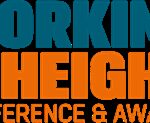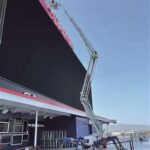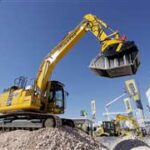Working on a boom lift feels awesome.
You’re soaring high, fixing things, installing massive beams like a boss.
But let’s be clear: heights don’t forgive mistakes.
Every year, accidents happen—not because the machines fail, but because people cut corners.
If you want to lift smart, live long, and keep OSHA inspectors smiling, these 10 tips are your golden ticket.
🛠️ 1. Always Wear a Harness (And Actually Clip It In)
This isn’t optional.
Boom lifts = fall arrest, not fall protection.
-
Wear a proper harness.
-
Attach your lanyard to the designated anchor point.
-
Double-check your D-ring.
Because “I forgot” isn’t going to slow gravity down.
🧠 2. Inspect the Machine Before Every Use
Would you sky-dive without checking your parachute?
Same idea.
-
Walk around the lift.
-
Check tires, hydraulics, batteries, guardrails.
-
Test tilt alarms, brakes, steering, and platform controls.
If something feels off—it probably is. Don’t roll the dice.
🧹 3. Keep the Platform Clear and Clean
Trip hazards at ground level? Annoying.
Trip hazards at 80 feet? Potentially fatal.
-
Tie down tools.
-
Don’t pile equipment loosely.
-
Keep debris off the floor.
Treat your platform like the deck of a yacht—neat, clean, secure.
🛑 4. Know Your Load Limits (and Stick to Them)
Every boom lift has a maximum rated load—including workers, tools, materials, and your lunchbox.
Overloading = higher risk of tip-over, mechanical failure, and epic regret.
Check the load chart.
Then actually respect it.
🧱 5. Only Work on Firm, Level Ground
Boom lifts love flat, stable surfaces.
-
No soft soil.
-
No cracked pavement.
-
No sneaky underground voids.
Use outriggers or mats if needed.
One bad pothole = one bad headline.
🎢 6. Don’t Move the Lift Unless It’s Safe
Yes, many lifts can drive elevated.
No, you shouldn’t just “creep forward” casually at full height.
Before driving:
-
Lower the platform if possible.
-
Scan the entire route.
-
Go turtle-slow.
-
Use a spotter if visibility is bad.
Shortcut = short career.
🌬️ 7. Respect Wind Limits
That “gentle breeze” feels different 80 feet up.
Boom lifts have strict wind speed limits (often 28 mph/45 km/h).
Always check:
-
Weather apps
-
Site conditions
-
Manufacturer ratings
If in doubt, lower it down.
Wind doesn’t play fair at altitude.
🚧 8. Watch for Overhead Hazards
Boom lifts love to find:
-
Power lines
-
Beams
-
Pipes
-
Signage
Maintain safe distances.
Electricity, steel, and surprise crossbars are not your friends when you’re 40 feet in the sky.
👀 9. Stay Focused
Multitasking is great for emails, terrible for boom lifts.
-
No phones while moving or lifting.
-
No goofing around on the platform.
-
No guessing where you’re driving.
One distracted second = one preventable accident.
Your only job up there? Work carefully, finish safely.
📚 10. Get Trained—and Stay Trained
You wouldn’t operate a bulldozer without a license.
Don’t operate a boom lift without proper training either.
-
Operator certification is mandatory.
-
Know the emergency lowering procedures.
-
Refresh your skills annually or when switching equipment types.
Training = confidence = survival.
🏁 Final Thoughts
Boom lifts are marvels of modern engineering.
They let you touch the sky—and get the job done faster, better, safer.
But no matter how advanced the lift is, the real safety system is you.
Harness up. Stay smart. Move slow. Think twice.
And you’ll not only reach the heights—you’ll reach them again and again.
Work high, work proud, work safe.




